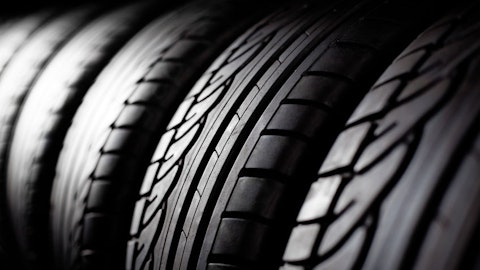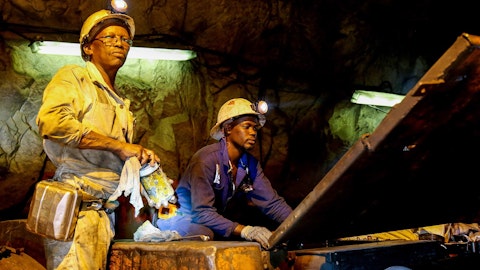This will enable closed-loop partnerships with automotive, electronics and consumer good customers that currently produce end-of-life plastics. These partnerships are highly attractive to our customers as they provide circular solutions. In addition to the sustainability advantages of our technology, quality of polycarbonate that we extract through the dissolution process is on par with virgin PC and contains lower levels of residual bisphenol A. These reduced BPA levels could potentially expand the types of applications for which recycled PC is approved. Our process also emits up to 3x less CO2 than virgin PC production, making both the process and end products more sustainable. Finally, because this technology permits the use of lower value waste and feedstock as feedstock, we anticipate at scale, it will result in cost savings compared to virgin PC production.
I’d like to thank our research and development team for their truly innovative work and their dedication towards creating a cleaner, more circular polycarbonate technology. This is just one of the many exciting projects that we continue to focus on in order to achieve our 2030 sustainability and growth goals and continue to increase the mix of specialties in our portfolio. Now I’d like to turn the call over to Dave.
David Stasse: Thank you, Frank. Our third quarter adjusted EBITDA was below our expectations due mainly to lower styrene-related margin from our unplanned outage at Terneuzen as well as negative net timing from decreasing raw materials. Results included unfavorable impacts of $15 million related to the Terneuzen styrene outage, $11 million from natural gas hedge losses and $4 million from net timing. Please note that the $11 million impact from natural gas hedges has decreased from $19 million in the first quarter and $12 million in the second quarter. We expect this impact to be about $5 million in the fourth quarter and about $5 million overall in 2024. In the second quarter, we had free cash flow of $16 million, including a working capital reduction of $52 million, which was driven by continued cash initiatives.
Year-to-date, we have reduced working capital by over $150 million, and over 80% of this reduction is from lower working capital days as opposed to price. We are comfortable operating at this reduced level of working capital as long as this demand environment persists. We ended the third quarter with $279 million of cash and $495 million of liquidity, including our undrawn bank facilities. The last item I’d like to discuss is our recent refinancing. As Slide 13 in our deck shows, we refinanced $660 million of the [2024] term loan and $385 million of the 2025 senior notes, extending these maturities to 2028. This leaves $115 million of notes due in September 2025 and no other maturities until 2028. Now I’ll turn the call back over to Frank, who will talk about our expectations for the remainder of 2023.
Frank Bozich: Thanks, Dave. Looking at our forecast for the rest of the year, we’re guiding to a full year net loss of $509 million to $499 million and adjusted EBITDA of $175 million to $185 million. This updated full year adjusted EBITDA outlook is below our prior guidance, primarily from lower styrene-related margin and unfavorable net timing in Q3 as well as a more pronounced year-end seasonality impact in Q4. As we continue to navigate a sustained low demand environment, we’ve been proactive by taking significant action to enhance profitability and cash generation, including numerous initiatives regarding asset optimization, cost reductions and liquidity improvements. The year-over-year benefit of these actions, combined with lower losses from natural gas hedges, our expected results in over $100 million of EBITDA improvement.
In addition to these improvements, the 2023 adjusted EBITDA outlook includes Q3 year-to-date unfavorable impacts of $22 million from net timing from declining raw materials and $14 million from fixed cost under absorption related to our inventory reduction actions. Therefore, we expect these tailwinds to result in significantly higher profitability in 2024. Now we’re happy to take your questions.
Operator: [Operator Instructions] We’ll go first this morning to Frank Mitsch at Fermium Research, LLC.
Frank Mitsch : Congrats on the refi. I want to drill a little bit more into the ’24 expectation versus ’23. You outlined a $100 million benefit from the cost actions that you’ve taken, the plant shutdowns as well as natural gas hedges. And so far this year, you had — you mentioned the $14 million under-absorption from running your assets late. Of course, you got — you also had another $15 million of unplanned outage. If I add this up, that $100 million that you’re expecting something like $40 million less in terms of nat gas hedges impact. So that implies $60 million benefit from the restructuring actions. I believe you’ve previously said you expected like $70 million to $90 million of benefit from the restructuring actions. Are we just rounding here? Can you talk a little bit more about the bridge from ’23 to ’24 from some of these various noise items?
Frank Bozich : Yes, Frank, I think the best way to look at it is to look at Slide 4 of the presentation deck, where we talk about the tailwinds. There’s a little call-out box there that shows $100 million related to the asset and cost restructuring and natural gas hedges, the $22 million of unfavorable net timing, plus $14 million fixed cost under absorption. So I would say those are the tailwinds that we would go into next year with the benefit of. And again, I think Q3 is representative of the demand levels that we would expect to see in this environment as we bounce along at these levels. So a normalized Q3, plus those, is probably a good way to think about it in this environment.
Frank Mitsch : Got you, got you. You previously indicated like $70 million to $90 million just based on the restructuring actions from the plant shutdowns, et cetera. It looks like that $100 million includes that as well as the $40 million benefit from the nat gas. You’re not implying that you’re expecting the benefits to be less than that $70 million to $90 million that you’ve previously said. Are you…?


